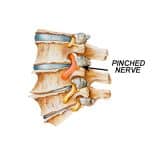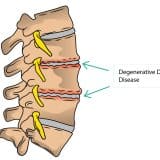Lumbar Spine Stenosis

The lumbar spine includes five different vertebrae in the lower portion of your spine between the pelvis and your ribs. Lumbar spinal stenosis occurs when the spinal canal narrows down, compressing all nerves traveling down from the lower back to the legs. It can affect young patients because of developmental reasons; most likely, it is a progressive condition that occurs in people who are above age 60.
Causes of lumbar spinal stenosis
Narrowing usually occurs gradually over several years. The discs start becoming less soft when you age, which leads to loss of height of the disc and can cause disc swelling in the spinal canal. Bone spurs also form, and ligaments start thickening. All of these result in central canal narrowing, leading to lumbar spinal stenosis, and may or may not cause symptoms. All symptoms arise because of nerve compression, inflammation, or sometimes both.
Osteoarthritis is one of the primary causes of lumbar spinal stenosis, where your joints undergo wear and tear slowly over time. Women are at more risk of osteoarthritis and lumbar spinal stenosis.
Some of the other conditions that can cause lumbar spinal stenosis are:
- Narrowing of the spinal canal for any reason
- Spinal injury
- Tumor in the spine
- Diseases of the bone
- Any spine surgery
- Rheumatoid arthritis
Symptoms of lumbar spinal stenosis
In the initial phase, people with lumbar spinal stenosis might not show any symptoms, but over time, symptoms may develop. Some of the symptoms of lumbar spinal stenosis are:
Back pain
Based on the degree of arthritis that has developed, people suffering from lumbar spinal stenosis may experience back pain.
Sciatica
When pressure increases on the spinal nerves, it leads to pain in the areas to which the nerve supplies. This pain can be either a burning feeling or an ache. It mainly begins in areas like the buttocks and goes down towards the leg. It can also cause pain in the foot.
Numbness in legs or buttocks
With more pressure on the nerves, numbness and tingling accompany the burning pain and ache that develops initially.
Leg weakness
When the pressure in the leg reaches a high level, weakness develops in either one or both legs. Some people with lumbar spinal stenosis also develop foot drop or feel that their foot is slapping on the ground while walking.
Cauda Equina syndrome
This is a rare condition and medical emergency that needs quick treatment. When nerve compression becomes severe, people feel numb in their private area and often lose control of their bladder and bowel. Sometimes strength in the legs also decreases, and one may face difficulty walking.
If all these symptoms show, you might require emergency surgery.
How is lumbar spinal stenosis diagnosed?
A neurosurgeon will diagnose lumbar spinal stenosis by taking into account the patient’s history, symptoms, physical examination, and test outcomes. Some of the imaging studies used for diagnosing are:
- X-ray
- CT scan
- MRI
- Myelogram
Treatment of lumbar spinal stenosis
Several healthcare professionals can help treat lumbar spinal stenosis, like arthritis specialists, physical therapists, surgeons, and nerve specialists. Treatment mainly involves:
Physical therapies
This includes various exercises for strengthening your leg muscles, back, and stomach. Knowing how to carry out activities safely, using braces for supporting your back, and stretching and massaging also help.
Medicines
Medicines mainly include non-steroidal and anti-inflammatory medicines that help relieve pain and swelling. Sometimes, steroid injections are also given to decrease swelling.
Surgery
This mainly includes the removal of the bone spurs and increasing the space that exists between the vertebrae. Surgery also stabilizes the lower back by fusing some of the vertebrae.
Along with all these treatment options, acupuncture and chiropractic treatment also helps. The healthcare professional decides the proper treatment based on the patient’s condition.
Conclusion
So, lumbar spine stenosis is a complicated syndrome involving degenerative progressions in the lumbar spine. This can result in painful clinical conditions, which are investigated through imaging examinations. Varied treatments are available, and the healthcare professional decides the most effective one based on the test results and symptoms.
For enquiries and online appointments:
Email – naveen.st@gmail.com
Call/Whatsapp – +91 7676090119
Visit www.naveenspine.com to know more.




